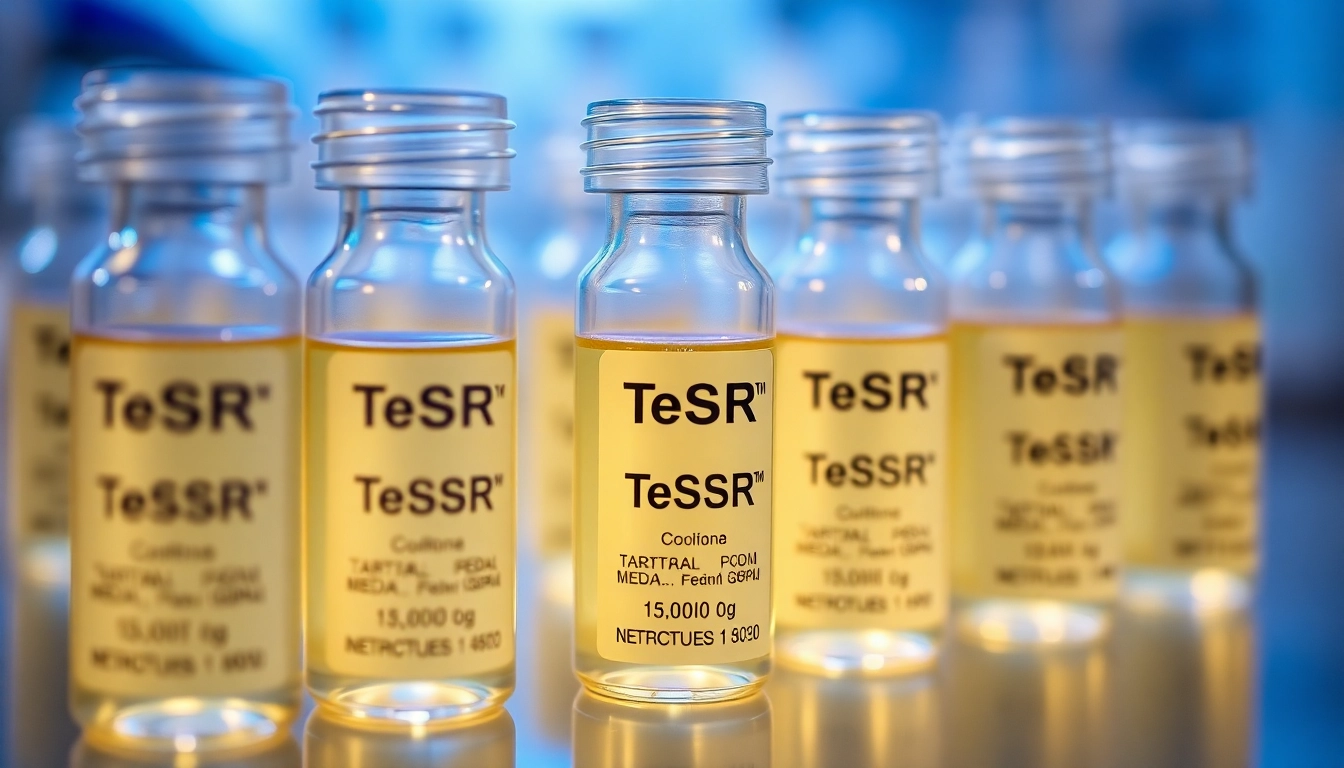Introduction to TeSR™ and Feeder-Free Media
The field of regenerative medicine and cellular biology has experienced rapid development, particularly with the advent of pluripotent stem cell (PSC) technologies. Among the most significant advancements has been the introduction of feeder-free culture media, specifically the TeSR™ product line developed by STEMCELL Technologies. All check to guarantee effective and consistent culture conditions is pivotal for the successful maintenance, expansion, and differentiation of human embryonic stem cells (hESCs) and induced pluripotent stem cells (iPSCs).
What is TeSR™?
TeSR™ represents a series of feeder-free culture media designed to support the growth and maintenance of human pluripotent stem cells (hPSCs). These products have been meticulously formulated to provide the essential environmental factors that facilitate optimal cell viability and functionality. The media are rooted in research from the laboratory of Dr. James Thomson, a pioneer in stem cell research. The original formulation, mTeSR™1, was revolutionary because it allowed for the culture of stem cells without the need for mouse embryonic fibroblast feeders, thus overcoming the limitations and risks associated with xenogenic contamination.
Importance of Feeder-Free Culture Systems
Feeder-free systems are crucial for a number of reasons. Firstly, they reduce variability in cell cultures caused by external influences, such as differences in feeder cell quality or variation in serum components. Secondly, these systems allow for a more defined culture environment, which is essential for the maintenance of pluripotency and integrity of stem cells. Furthermore, they facilitate easier handling and manipulation of cells, making downstream applications such as differentiation and drug testing more feasible and reliable.
Overview of Available TeSR™ Products
The TeSR™ media family includes a diverse array of products tailored for different stages of stem cell research. This includes:
- mTeSR™1: The foundational feeder-free medium for hPSC maintenance.
- mTeSR™ Plus: Enhanced formulation with improved buffering and stability for long-term cultures.
- TeSR™-AOF: An animal origin-free medium that reduces concerns related to contamination.
- TeSR™-E8™: A simpler formulation containing essential components to maintain hPSCs.
- ReproTeSR™: Specified for the reprogramming of fibroblasts and other somatic cells into induced pluripotent stem cells.
- STEMdiff™ Line: For differentiation into specific cell types from hPSCs.
- Cryopreservation Media: Designed for efficient storage of stem cells, ensuring their viability upon thawing.
Benefits of Using TeSR™ Media
Enhancing Cell Quality and Viability
One of the primary advantages of TeSR™ media is their ability to enhance the quality and viability of hPSCs. These formulations are designed to maintain pluripotency and genomic integrity while promoting cell division and growth. For instance, mTeSR™ Plus features stabilized components such as basic fibroblast growth factor (FGF2), which are crucial for the maintenance of stem cell characteristics. Additionally, the buffering system of this medium helps minimize medium acidification, an important factor for preserving cell viability during extended culture periods.
Batch-to-Batch Consistency Explained
Batch-to-batch consistency is essential for research reproducibility and reliability. Researchers employing TeSR™ media can expect a high degree of consistency thanks to the rigorous pre-screening of raw materials and stringent quality control measures in production. Each batch of TeSR™ media undergoes comprehensive testing to assure performance characteristics that align with previous batches, thereby facilitating dependable experimental results.
Applications for Human Pluripotent Stem Cells
TeSR™ media are versatile and find numerous applications in pluripotent stem cell research. These include:
- Cell Reprogramming: Efficiently converting somatic cells into iPSCs.
- Stem Cell Maintenance: Sustaining undifferentiated hPSCs for extended periods.
- Cell Differentiation: Guiding hPSCs towards various specialized cell types, such as neurons, cardiomyocytes, and insulin-producing cells.
- Cryopreservation: Safely storing stem cells for future use with high recovery rates.
Comparative Analysis: TeSR™ vs. Competitors
Key Features of TeSR™ Media Family
When assessing TeSR™ media against competitors, several key features stand out:
- Feeder-Free Formulations: Ensuring reduced contamination risks and simplified handling.
- Xeno-Free Options: Enhancing safety for research applications by eliminating animal-derived components.
- Robust Performance: Proven effectiveness in maintaining stem cell characteristics across numerous peer-reviewed studies.
Market Positioning and Competitive Advantage
The TeSR™ family positions itself strongly within the market due to its historical success and comprehensive range of applications. With over 1100 publications utilizing mTeSR™1 alone, the product line has established a trusted reputation amongst researchers. Additionally, the continuous innovation of new formulations ensures that users are equipped with the latest advancements in stem cell culture technology.
User Feedback and Performance Metrics
User feedback consistently highlights the effectiveness and reliability of TeSR™ products. Metrics such as cell proliferation rates, differentiation efficiency, and long-term viability indicate that the products deliver superior performance compared to many alternatives. Researchers have reported improved results in experiments involving complex cellular behaviors, including spontaneous differentiation and misuse of stem cell-derived progeny.
Guidelines for Optimal Use of TeSR™ Products
Protocol for Reprogramming using TeSR™ Media
Utilizing TeSR™ media for reprogramming initiatives involves a structured approach. The following steps outline a basic protocol:
- Harvest somatic cells and culture them in a standard medium until about 70% confluency.
- Transfer the cells to a TeSR™-E7™ culture environment.
- Integrate reprogramming factors (e.g., OCT4, SOX2, KLF4, and cMYC) via a transduction method.
- Maintain the cells under optimal conditions specified for TeSR™-E7™ and monitor periodically for colony formation.
- After 12–14 days, evaluate colonies for iPSC characteristics using markers for pluripotency.
Best Practices for Maintenance and Differentiation
To ensure optimal outcomes when using TeSR™ media for maintenance and differentiation, the following best practices are recommended:
- Regularly monitor pH levels and replace media in a timely manner to prevent acidification.
- Avoid over-confluence by splitting cultured cells at 60-80% confluency.
- Utilize the specific differentiation protocols associated with the desired cell type for effective results.
- Maintain sterility and avoid contamination by using proper aseptic techniques.
- Regularly evaluate cells for morphology and marker expression indicative of pluripotency or differentiation.
Troubleshooting Common Issues
Even with the best practices, challenges may arise when using TeSR™ media. Common issues and solutions include:
- Decreased Cell Viability: Ensure proper media composition and environmental conditions are maintained.
- Poor Differentiation Outcomes: Reassess the differentiation protocol and verify the use of appropriate cytokines and growth factors.
- Contamination: Investigate the aseptic techniques and consider the use of antibiotics within the medium.
Future of Pluripotent Stem Cell Research with TeSR™
Innovations in Feeder-Free Media
The evolution of TeSR™ media indicates a commitment to continuous innovation in stem cell research. Future products may include enhanced formulations featuring even more targeted components to optimize differentiation pathways and maintain cellular integrity. Furthermore, developments in automated systems for media dispensing and monitoring could streamline lab processes, significantly reducing manual workload.
Long-Term Impact on Stem Cell Therapies
As regenerative medicine advances, the role of high-quality culture systems like TeSR™ will be fundamental in translating research from bench to bedside. By providing reliable tools for stem cell research, the TeSR™ media family can facilitate the development of novel therapies for conditions such as diabetes, heart disease, and neurodegenerative disorders, potentially leading to improved patient outcomes.
Research Collaborations and Opportunities
The pathway forward for stem cell research will necessitate collaborations across disciplines, including bioengineering, genomics, and clinical medicine. STEMCELL Technologies’ dedication to research collaborations can foster innovation and ensure that the TeSR™ product suite remains aligned with the evolving needs of the scientific community, creating opportunities for groundbreaking discoveries in stem cell biology.



